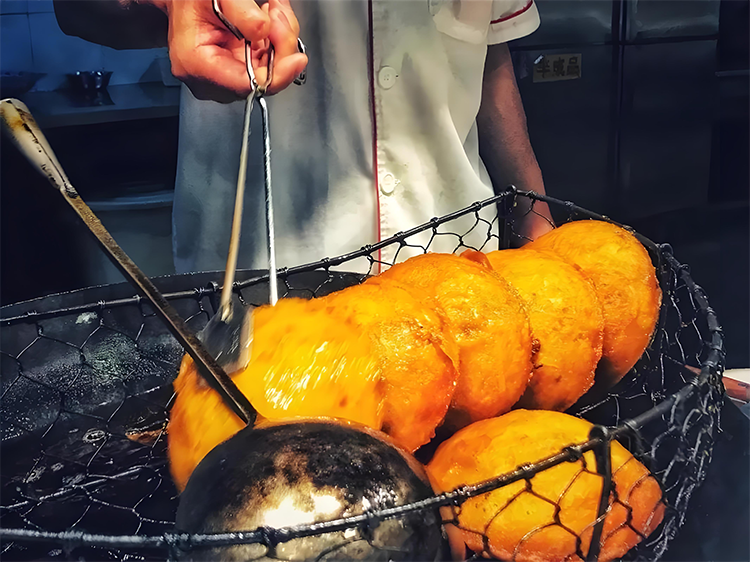Wenzhou Lantern Cake: Six Centuries of Golden Crisp
Introduction
In the winding lanes of Wenzhou, an irresistible aroma often appears without warning—a warm mix of toasted rice and soybean, sweet radish, and savory pork fat. Follow that scent and you’ll find small, lamp-shaped golden cakes sizzling out of a bubbling wok. This is Wenzhou Lantern Cake, the city’s famed street food and a fried treasure that carries nearly 600 years of history.

1. Origin and Legends: A Cake Born from an Oil Lamp
Wenzhou lantern cake (locally known as dengzhan gao) traces back to the late Yuan and early Ming dynasties. The name comes from its shape: cooks would pour rice-soy batter into a flat, round iron ladle that yielded a thicker center and thinner rim—resembling an ancient oil lamp or “lantern.” A widely told legend says scholars traveling to imperial exams favored these cakes as portable, high-energy rations. Others say the lantern cake reflects Wenzhou’s practical, frugal spirit—turning everyday rice, beans, and radish into something unexpectedly delicious. Over time this humble snack became a living relic of local memory and craftsmanship.
2. Ingredients and Craft: Turning Simple Staples into Crisps
What makes the Wenzhou lantern cake special is the transformation of basic ingredients. The batter is usually a well-balanced slurry of soaked rice and yellow soybeans, ground into a thick, even paste. A little wheat flour may be added to enhance crispness. The fillings are the soul: shredded white radish (daikon), seasoned minced pork with the right fat-to-lean ratio, and often an entire egg.
A skilled vendor ladles batter into a round iron spoon, layers a generous mound of radish and pork, cracks in an egg, then seals it with more batter. It’s then immersed in hot oil—quickly puffing, setting, and turning a radiant golden brown. The timing, oil temperature, and dexterity are essential; a seasoned cook’s hands make the difference between good and unforgettable.

3. Flavor and Texture: A Symphony in One Bite
A fresh lantern cake is a textural orchestra. The deep-fried shell is remarkably crisp—thin edges shatter while the rim remains tender. Inside, the radish keeps a pleasant crunch and slight sweetness that cuts through the oil; the pork gives savory ballast; the egg centers the bite with a semi-runny yolk that harmonizes every note. Rice aroma, soybean nuttiness, and frying fragrance combine into a layered, lingering taste you won’t forget.
4. How to Eat It: Local Pairings and Etiquette
Eat lantern cake hot, straight from the stall. Vendors often wrap it in kraft paper to protect your hands—blow once or twice, then take cautious bites because the filling can be piping hot. Locals enjoy lantern cake with light soups such as seaweed soup or a warm soy milk; the mellow broth balances the fried richness and makes a satisfying meal at breakfast, afternoon snack, or late-night comfort food.

5. Where to Find the Most Authentic Lantern Cake
For visitors seeking authentic Wenzhou lantern cake, head to the old city streets and traditional markets—areas like Wuma Street and Jiefang Road frequently hide reputable, long-running stalls. Look for vendors working on open woks and for queues of locals; freshness and a steady line are good signals. Expect a basic lantern cake with radish and pork to cost around 5–8 RMB; adding an egg raises the price slightly. Watching the live-making process is part of the experience.
6. Try It at Home: A Simple Version of Lantern Cake
If you want to recreate lantern cake, simplify the method: use glutinous rice flour or rice flour mixed with soybean powder rather than wet-milling grains. Grate the radish and squeeze excess water, season store-bought minced pork, and use a deep spoon as a mold greased with oil. Pour batter, add filling and an egg, and shallow-fry or deep-fry until golden. It won’t fully match a market vendor’s airy crispness, but you’ll capture the core flavors and enjoy hands-on fun.

7. Conclusion
Wenzhou lantern cake is more than a snack—it’s a little golden emblem of a coastal city’s history and daily life. With humble ingredients and expert technique, this fried cake tells stories of travel, thrift, and communal taste. When you stroll through Wenzhou’s alleys, don’t miss the chance to bite into one: you’ll taste six centuries of warmth, craft, and memory.


